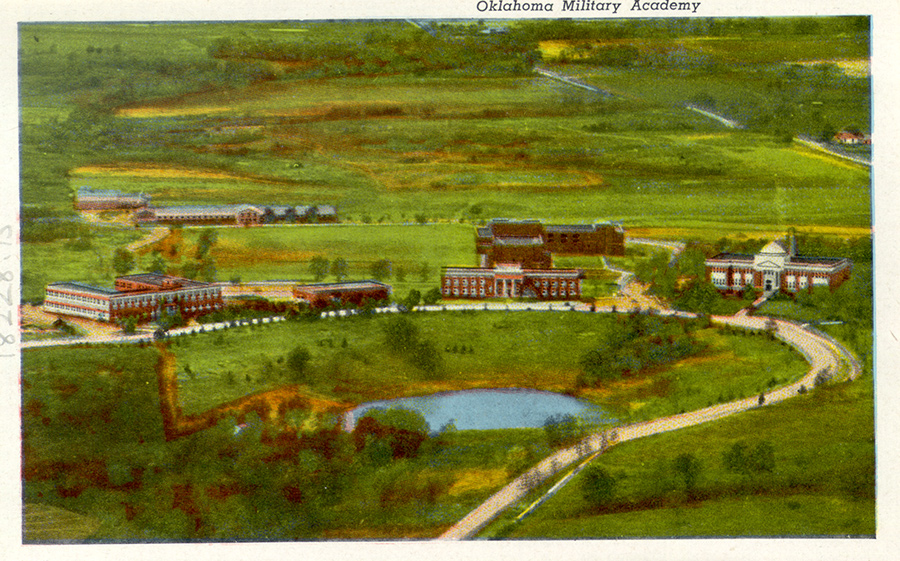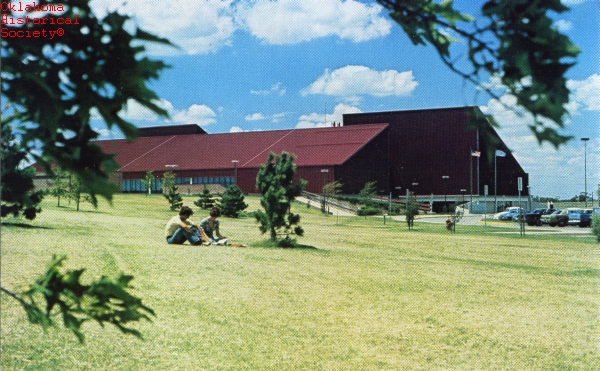The Encyclopedia of Oklahoma History and Culture
JUNIOR COLLEGE MOVEMENT.
The desire to establish postsecondary institutions achieved status early in Oklahoma's education history. The 1907 constitution mandated the establishment of liberal arts colleges as well as agricultural-vocational courses to train young people for scientific farming and various trades. Teacher training and agriculture degrees, for example, were offered by the state's four-year, regional institutions. However, many students who could not or chose not to attend a larger college still wanted additional education, and their needs coincided with the junior college movement. A "junior college" provides two years of college-level courses after high school graduation.
At the same time, the Progressive Education movement was adding vocational courses to high school curricula as well. "Education for daily living" was the goal, so in addition to English, history, and mathematics, students could study shorthand and typing or participate in woodworking classes or team sports. This philosophy extended into the junior college curricula. In postsecondary work, students could take the core academic subjects required for general college education and could branch out into professional training.
Private junior colleges had begun appearing around the nation in the mid- to late-nineteenth century. The first publicly supported institution in the United States was established in Illinois in 1901. A few appeared in Oklahoma around that time. The movement to extend education past the secondary level, and to use tax money to fund the process, resulted in the founding of the American Association of Junior Colleges in 1920.
Junior colleges became very popular, for simple reasons. As urbanization increased, even in mostly rural Oklahoma, more young people needed to be able to make a living in non–agriculture-related occupations. Therefore, a variety of educational venues developed, generally in three categories: private, state-supported, and municipal. Each had its own philosophy and objectives. Some prepared students for transfer to a four-year liberal arts college. Others provided technical and vocational training to aid students in getting better jobs. At the very least, all offered an opportunity for personal self-improvement. Regardless of its affiliation and mission, a junior college usually served only the population of the town in which it was located.
Private two-year colleges, run by religious denominations, actually emerged before the municipal or state-supported varieties. The first was Indian University (Baptist), now Bacone College, founded in 1881. It was followed by such entities as Calvin Institute (Oklahoma Presbyterian College for Girls) at Durant, 1896, Oklahoma Holiness College (Bethany-Peniel College, Nazarene) at Bethany, 1909, Sacred Heart College (St. Gregory's College, Catholic) at Shawnee, 1915, and Monte Cassino (Catholic) at Tulsa, 1926. The African Methodist Episcopal Church established Flipper-Key-Davis University (later Junior College) at Tullahassee in 1914. Davis closed in 1935. Bacone remains a two-year institution, and Monte Cassino is a high school. Bethany and St. Gregory's became four-year schools. Hillsdale Free Will Baptist College at Tulsa/Moore, was established in 1959; it became a four-year school in 1972. Similarly, Oklahoma Christian College (1950, now in Oklahoma City) and Bartlesville Wesleyan College (1960, now Oklahoma Wesleyan University) started as two-year programs and became four-year degree-granting schools. Another, Southwestern Bible College (Oklahoma City and Bethany, 1940) became the state's largest private junior college.
The State of Oklahoma began providing tax support for two-year colleges in 1901 by founding University Preparatory School at Tonkawa. In 1908 six more lower-division facilities were envisioned, of which four became reality: Connors State Agricultural College at Warner, Murray State School of Agriculture at Tishomingo, Cameron State Agricultural College at Lawton, and Panhandle State School of Agriculture at Goodwell. Also in 1908 the legislature created the Oklahoma School of Mines and Metallurgy at Wilburton, a two-year technical school, and in 1909 set up the Eastern University Preparatory School at Claremore (later Oklahoma Military Academy and Rogers State University). While most were technical schools, the preparatory schools readied students for the university. The Lawton, Goodwell, and Claremore schools became four-year institutions.
Publicly supported municipal junior colleges abounded in the early 1920s as local economies profited from agriculture and oil. Those schools that were furthest away from state colleges lasted longer. Town and city school districts that established public junior colleges usually used the existing local high school building as the campus and often employed the high school teachers as the faculty. In 1920 Muskogee established Oklahoma's first municipal junior college, and the school operated continuously through the year 1962.
Between 1920 and 1939 thirty-four others were created by city school districts. These schools' longevity varied and tended to follow the economic fortunes of the communities where they functioned. For example, Chickasha's (1924) lasted for only one year, Pauls Valley's (1924) lasted for four, and Altus's (1925), Seminole's (1931), and El Reno's (1938) lasted for ten or more years. Douglass High School in Oklahoma City, for instance, offered college work for African American students; Capitol Hill High School in the city had one of the largest enrollments in the state.
The junior college movement did not develop without challenges. Through the 1930s the State had no method of controlling the municipal institutions, although the State Board of Education did have an accreditation process for them. With no legal basis for operating the schools, school boards often allowed them to temporarily or permanently lapse during economic hard times. The 1939 Oklahoma Junior College Act legalized the practice of using public schools for college-level offerings and allowed school districts to charge tuition. However, it did deny the right to tax specifically for their support, and some municipal colleges continued to be a drain on regular school budgets. Nevertheless, by 1940 only California and Iowa had more municipal colleges than Oklahoma, although during World War II many closed as students went to war or worked on the home front. In 1944 only nine schools remained, but at war's end others were created, so that by 1946 there were sixteen. By 1952 the number had decreased to six, as more students chose to attend the state's four-year colleges.
The State of Oklahoma gradually assumed oversight of the municipal colleges. Since 1941 they have been governed by the Oklahoma State System of Higher Education, which is directed by the State Regents for Higher Education. In 2003 the system included Connors (Warner), Carl Albert (Poteau), Eastern Oklahoma (Wilburton), Murray (Tishomingo), Northeastern Agricultural and Mechanical (Miami), Northern Oklahoma (Tonkawa), Oklahoma City Community College, Oklahoma State University's Oklahoma City and Oklmulgee branches, Redlands (El Reno), Rose (Midwest City), Seminole (Seminole), Tulsa Community College, and Western Oklahoma (Altus). They are supported by money from the general revenue fund, with three of the schools receiving additional support from local property tax levies. The total enrollment is approximately seventy-two thousand. Junior colleges, or "community colleges," as they came to be called in the 1960s and 1970s, offer associate of arts degrees, and graduates may transfer to one of the state-supported four-year colleges. The Oklahoma Association of Community and Junior Colleges, founded in 1927, functioned through the twentieth century.
See Also
COLLEGES AND UNIVERSITIES–NORMAL, COLLEGES AND UNIVERSITIES–PRIVATE, COLLEGES AND UNIVERSITIES–STATE
Learn More
Frank A. Balyeat, "Junior Colleges in Oklahoma," The Chronicles of Oklahoma 26 (Spring 1948).
A. L. Crable, "Public District Junior Colleges," Eighteenth Biennial Report of the State Superintendent of Public Instruction (Oklahoma City: State Board of Education, 1940).
Ohland Morton, "Junior Colleges in Oklahoma," Junior College Journal 5 (Number 3, 1933).
Larry A. Nutter, "A History of Junior Colleges in Oklahoma" (Ph.D. diss., University of Oklahoma, 1974).
Michael W. Simpson, "Enigma and Battleground: The Development of Oklahoma's Public Two-Year Colleges," The Chronicles of Oklahoma 87 (Fall 2009).
Citation
The following (as per The Chicago Manual of Style, 17th edition) is the preferred citation for articles:
Dianna Everett, “Junior College Movement,” The Encyclopedia of Oklahoma History and Culture, https://www.okhistory.org/publications/enc/entry?entry=JU005.
Published January 15, 2010
© Oklahoma Historical Society



